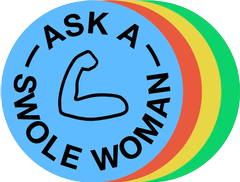Illustration by Elnora Turner
Sick of clean eating, perfect gym outfits, and chiseled abs? A Swole Woman is here to help you be healthy, enjoy carbs, and get jacked.
Advertisement
Thanks! —FitGirlMelissa Alcantara, a.k.a. @fitgurlmel, is, to me, a local hero of fitness social media. She is, first and foremost, incredibly jacked and strong. She also strikes an incredible balance between giving the people what they want in the form of accessible workout programs, while being unambiguously clear that she doesn’t look that way from doing little bicycle crunches and planks; she is super clear about where her own physique came from (strength training) and what the work involved there is. I like to think that, like Alcantara, I am also brutally honest about where my physique came from (somewhat less strength training, somewhat more ice cream).
Since everyone is on the verge of trying to do their Hot Girl Post Pandemic Summer Body, I want to talk about this. I don’t want to necessarily draw you a roadmap to looking like Melissa Alcantara. But I do want to talk about what we are really looking at when we look at her (or me!), and what lies under the surface. This is not really that big of a mystery, if you know what to pay attention to.
Advertisement
Before I started lifting, I spent well over a decade doing some form of “dieting,” eating a pretty meager amount of food and trying to “burn” any and all body fat by doing cardio. Over all these years of dieting, I hoped if I could just grit through smaller and smaller amounts of calories and more and more cardio, the “toned” body I wanted would reveal itself.
Even though I wasn’t at any point on my deathbed, all this dieting had a very negative impact on my body. I had dieted so much there were no muscles for me to even diet down to: I would lose weight too aggressively and lose muscle along with body fat, and then my body would try to bounce back to a healthy weight, regaining mostly fat. It was exhausting and sucked; I never got to a point where I felt I didn’t have to think about all of this constantly, and I was making it even harder by laying waste to all my muscles and fucking up my metabolism over the years. (If you’re wondering if this means that crash dieting in order to have a temporarily “hot” body for the post-panny-D times may have longer term consequences than anyone selling a “fat burning workout” or 800-calories-per-day diet will tell you: That is exactly what I’m saying!)
Advertisement
Then I learned about lifting. I found out I could run this process of “destroying my body with yo-yo dieting” essentially in reverse, building back the muscle I’d lost and the strength I’d once felt. At first, like a lot of beginner lifters, I could lose body fat and gain muscle at the same time (“recomposition”), but eventually, in order to keep getting stronger, I needed to intentionally gain weight to gain more muscle (“bulking”), which could be then followed by losing a little body fat slowly and carefully (“cutting”), and then starting the bulking process over again. Each of these phases took me several months, so altogether, the fine specimen you see before you is years in the making, and fluctuates quite a lot. I got started on this with the r/Fitness wiki, and I found the book Renaissance Woman very helpful.This is how most people who are even a little muscular and strong keep getting stronger. While Alcantara doesn’t speak directly about bulking and cutting, she is a rare gem of a fitness expert because she is at least clear that she didn’t get the way she is overnight; she’s been on this road for literally a decade.Given how overwhelmed the fitness industry is with “overnight” transformations, “lose 15 pounds in ten days” type of marketing, Alcantara is actually pretty radical. Contrast this with someone like Chloe Ting, whose “2 week shredding challenge” and “abs in 2 weeks” videos have blown up over the course of the pandemic, and who doesn’t actually look that different from Alcantara, but remains mysterious about her own background.
Advertisement
Saying “I’d like to look like Melissa Alcantara” is not exactly the same as saying “I’d like to look like Arnold Schwarzenegger,” but it’s closer than I think you might think. And looking like either of these people is not impossible! But the wider fitness industry encourages us to hold ourselves to these kind of crazy standards and gives us only substandard tools to meet them (bicycle-crunch-oriented “Get Abs in 2 WEEKS”-ass workouts), and rakes in the profits when we get frustrated and blame ourselves when that doesn’t work out.
Building muscle aside, a lot of fitness influencers seem, to me, to obscure the truth about how hard being shredded is, because they are invested in making it look easy to you. As you note, some of it is about genetics, but a lot of it is about that background of building and maintaining muscle, which requires more calories than you might think; and then it’s about keeping low body fat, which means a lot of precision about those calories.
Advertisement
This is all also laying aside the issue of total illusions online (which I don’t believe is the case with Alcantara, but are rampant elsewhere), which may include:
- Body editing apps, yes, even in video
- A curated back stock of photos from lean “phases” posted to make it look like the person is incredibly shredded all day/all year
- Steroids (even if they are not jacked!)
- Cosmetic surgery, including liposuction and Brazilian butt injections
I don’t want to be a total Debbie Downer about having an “unreasonable” goal, because if I believe nothing else, it’s that you will at least learn a lot along to the way to not achieving what you might have set out to do, and may end up where you needed to be instead of where you intended to go.
When I started lifting, I was much more excited about the potential of looking muscular than I am now. Bulking was a scary prospect for me (thank you, internalized fatphobia!), but I found that I actually never felt better in my body than the first time I bulked. Through doing this, lifting gave me things I never knew I was missing and I am now so happy to have: a constructive relationship with food and my body, where we all work as a team to crush in the gym and generally feel good; a measured approach to health where rest and recovery is as important as work; powerful thighs; an appreciation for how I feel and what I can do, instead of how I look.
Advertisement
I also found that being even a little shredded was much harder than it looks, and not that fun; it was interesting to see, but the number of tradeoffs it involves, for me, at least, are not what a full life is made of. I don’t care to be lean more than I care to enjoy the flexibility in the kind of diet that comes with carrying an extra 10 (15)(20) pounds. Learning the positive feedback loop of building strength, and learning to accept myself at different body weights and compositions, has allowed me to enjoy my life, sans body/food preoccupations. It has done what looking hot could never do, including allowing me to like working out and not see it as a punishment or a cudgel for whipping my body into a state of attractiveness.
As I’ve written before, a past, very disordered version of me would have waved away this “how I feel and what I can do” stuff as hippie garbage, and would have thought that working out is simply too hard, time consuming, and undignified for it to not pay off in the most meaningful way of all, which is how we look. If the person saying it was hot, I’d think they were being a smug asshole, like when a rich person says “money isn’t everything”; if anyone else said it, I’d have thought they were bending over backward to justify not being able, or not caring enough, to just lose weight. I feel like I still see this behind the glazed-over eyes of a lot of people I talk to about lifting. And I understand it. There was a moment that lifting finally made sense to me and became a self-reinforcing process, where the more I did it, the better I felt, the happier I was, etc. But there were certainly times before that when I heard these kinds of “Work out to feel good, get excited about what your body can do,” messages, and simply could not connect with them. Possibly it was that they were always next to miserable HIIT workouts,1200-calorie-per-day diets, and photos of impossibly long-limbed, lithe women. Working out was a neverending chore where pain and torture was “the point,” food was the enemy, and bodies were for crushing into submission. That is, quite frankly, an existence that wouldn’t allow anyone to meaningfully achieve those feelings. So if your conception of working out sounds more like that than like strength training and you don’t believe me when I say “how it feels and what you can do matters,” I understand why.
I don’t think you’re a bad person for wanting to grasp the role of working out in being hot. But I think what I’m trying to say is, to everyone who struggles to conceive of working out as being for any real purpose but being hot, I hope that understanding what actually goes into being hot in the way someone like Melissa Alcantara is, might help you ultimately understand why working out is and needs to be about something other than being hot. If you insist on “being hot” being your only framework for understanding working out, then I guess know that treating the pursuit of hotness as anything but a marathon will probably hurt more than it helps, in the long run, and you’d just be making it harder and harder to be hotter, each subsequent time. I mean, how are you not tired just reading about this? Wouldn’t it be so much easier to focus on getting your deadlift form right? I personally think so; I welcome you to join me. Disclaimer: Casey Johnston is not a doctor, nutritionist, dietitian, personal trainer, physiotherapist, psychotherapist, doctor, or lawyer; she is simply someone who has done a lot of, and read a lot about, lifting weights.You can read past Ask A Swole Woman columns at The Hairpin and at SELF and follow A Swole Woman on Instagram. Got a question for her? Email swole.woman@vice.com.

